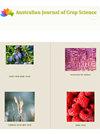The efficiency of liquid source nitrogen for foliar absorption in oat
Q3 Agricultural and Biological Sciences
引用次数: 0
Abstract
The objective of the study is to estimate the technical, economic and stability of nitrogen use efficiency in oats intercropped with soybean and corn in conventional management using urea and nutrient spraying for foliar absorption, considering the expression of biomass and grain yields in different cropping systems, subsidizing the validation of this technology. The study was carried out in Augusto Pestana, RS, Brazil, in a soybean/oat and corn/oat system. In each system, two experiments were carried out, one to quantify biomass yield and another to estimate grain yield, totally four experiments. In all experiments the design was randomized blocks with four replications in a 2x4 factorial, for 2 nitrogen sources (liquid and solid) with 4 doses (0, 30, 60 and 120 kg ha-1), respectively. The solid source (urea) with 45% of nitrogen for root absorption and the liquid source (N-Top®) with 28% of the nutrient for foliar absorption were applied at the phenological stage of the fourth expanded oat leaf. The analyzed variables were biomass and grain productivity, obtained by cutting the three central rows of each plot at the physiological and harvest maturity stages, respectively. The efficiency of using nitrogen from a liquid source via foliar absorption in oats promotes similar results when using urea. Regardless of the nitrogen source, doses of 45 and 75 kg ha-1 are more efficient in soybean/oat and corn/oat systems, respectively. Although the technical efficiency of liquid source nitrogen is proven, the high cost does not allow recommendation on a commercial scale燕麦叶片对液源氮吸收效率的研究
本研究的目的是在考虑不同种植制度下生物量和籽粒产量表达的情况下,评估尿素和养分喷洒叶片吸收的燕麦间作大豆和玉米氮素利用效率的技术、经济和稳定性,为该技术的验证提供资助。该研究在巴西RS的奥古斯托佩斯塔纳进行,采用大豆/燕麦和玉米/燕麦系统。在每个系统中,分别进行生物量产量量化和粮食产量估算2个试验,共4个试验。所有试验采用随机区组设计,4个重复,2 × 4因子,2个氮源(液体和固体),4个剂量(0、30、60和120 kg ha-1)。在燕麦膨化第4叶物候期施用含45%氮素的固体源(尿素)和含28%氮素的液体源(N-Top®)。分析的变量为生物量和粮食生产力,分别通过在生理和收获成熟期切割每个地块的三行中央获得。燕麦通过叶片吸收液态氮的效率与使用尿素的效率相似。无论氮源如何,45和75 kg hm -1的施氮量分别在大豆/燕麦和玉米/燕麦系统中更有效。虽然液源氮的技术效率已得到证实,但其高成本不允许在商业规模上推广
本文章由计算机程序翻译,如有差异,请以英文原文为准。
求助全文
约1分钟内获得全文
求助全文
来源期刊

Australian Journal of Crop Science
农林科学-农艺学
CiteScore
1.20
自引率
0.00%
发文量
75
审稿时长
3.5 months
期刊介绍:
Information not localized
 求助内容:
求助内容: 应助结果提醒方式:
应助结果提醒方式:


